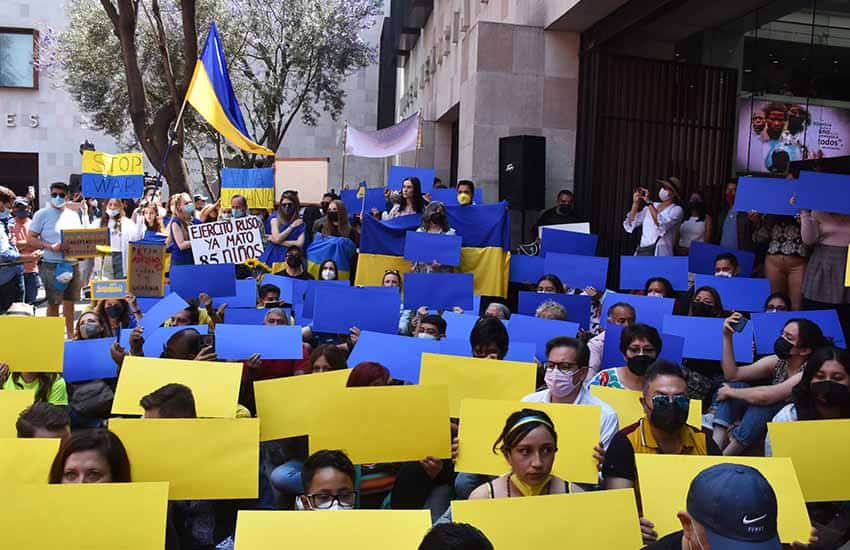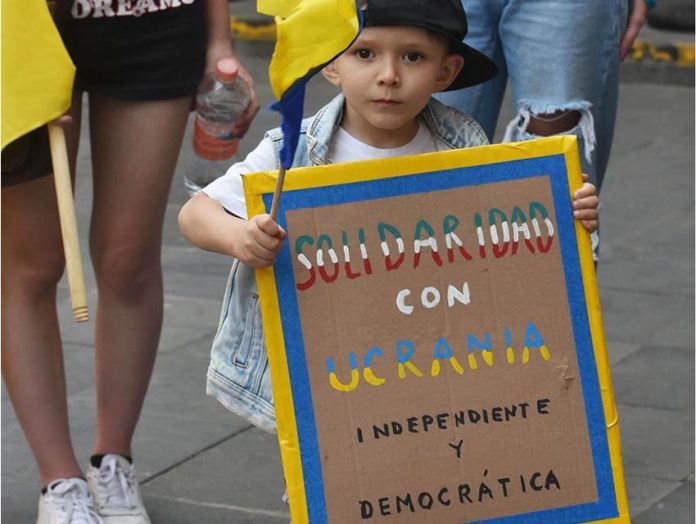When Russia invaded Ukraine, Aliona Starostenko, who moved from Ukraine to Mexico with her parents when she was eight years old, knew she had to do something.
“The war comes, and you forget everything,” she said. “It is scary to wake up and look at the news to see if the Russians have bombed another city. You can’t just sleep and cry, you need to put your energy into helping.”
Starostenko done just that: she collects humanitarian supplies and monetary donations to send to Ukraine. She sells items to raise more funds. She’s also worked with friends in Ukraine to get four people out of that country. Recently, she drove to Mexico City to deliver the supplies she’d collected and attend a protest.
She knows of humanitarian supplies being collected in Puebla, Mexico City and Querétaro. In Puebla, Starostenko estimates that around 40 people have made donations.
“We were specifically asked to collect things for babies and children,” she said. “Medicine, diapers, formula — things like that.”

Among the four people Starostenko has managed to evacuate from Ukraine are an uncle and niece. However, she’s been unable to get her mother — who has been in Ukraine since December 2020 — out of the Eastern European country.
Her mother returned there to care for Starostenko’s sick grandmother, who lives in Lviv.
“Now she is stuck,” Starostenko said. “She cannot move my grandmother.” And even if Starostenko finds a way to get her mother out of Ukraine, she says, her mom refuses to leave without her own mother.
The items Starostenko collects are shipped to Mexico City, where Elisa Irene Sotelo Schmelkes takes over, coordinating collections, classifying and packing everything, getting them ready to ship.
Sotelo, who is Mexican, said she got hands-on training for this when she volunteered in the aftermath of her country’s 2017 earthquake. She has no formal connection to Ukraine but, “I couldn’t not do anything,” she said.
“I’m good at organizing people,” she said. “They weren’t organized before. They needed someone who knew how to do stuff. I know how to do stuff.”
About 3.5 tons of supplies have been collected so far, she said. Unfortunately, there have been a couple of delays, meaning the supplies haven’t left Mexico yet. “We are waiting for a donor to pay to transport the humanitarian aid,” Starostenko said
Her husband Jorge Trejo said that they hoped supplies would soon be flown to Holland or Romania, and from there on to Ukraine.
Knowing that some people like to purchase items to show their support for Ukrainians, Starostenko is selling bright yellow T-shirts with the words Paz Ucrania (Peace Ukraine) printed on them for 250 pesos (US $12.50) and bumper stickers with the same slogan for 50 pesos (US $2.50). She’s also been collaborating with Cholula-based jewelry designer Martha Angélica Cabrera Figueroa.
Cabrera is making bracelets with a small Ukrainian coat of arms attached that Starostenko sells for 100 pesos. “I typically make 10 bracelets a week,” said Cabrera. “Now I am making 60.”
She’s selling them to Starostenko for just a few pesos above cost. “I make much more money when I sell them in my store, but I am doing this to help the cause,” she said.
On Sunday, Starostenko and Trejo could be found emptying a carful of supplies into a Mexico City office and then meeting up with Sotelo and Sofya Dolutskaya, a friend who was born in Russia but is a naturalized Mexican citizen, for a quick bite and some coffee.

Dolutskaya said he has lived in Mexico for 11 years. She began protesting against Russian aggression when the country’s military invaded Crimea in 2014. She found a Ukrainian group on Facebook and joined their protests.
She said that Ukrainians were impressed that a Russian would protest against her own country.
“Russian and Ukrainian people have lived side by side for so long,” Dolutskaya said. “It is not a matter of blood but a complete rejection of the imperialist mindset. I’m doing this because I think Putin and the government … have a Cold War and imperialist mentality.”
Dolutskaya and others have put together a news site on the cell phone application Telegram, where articles from a variety of sources are translated into Spanish. She said that Russians protesting against the war could be charged with high treason and given a prison sentence of 15 years.
“For the news site, I could get 20,” she said.
After a short break, the four friends headed to a protest scheduled by the Ukrainian Embassy and taking place in front of the Museum of Memory and Tolerance.
When they arrived, around 350 people, the majority wearing yellow and blue — the colors of the Ukrainian flag — gathered here to take part in “Elevamos Nuestras Voces” (We Elevate Our Voices) — the name of the protest. “I protest to get people to know the truth,” said Starostenko. “Protesting is effective because you make news and people become more aware. Maybe they will help.”
She said it was also a way to connect with other Ukrainians, “to help each other and to help families in Ukraine.”
Olena Strembitska, a Ukrainian at the protest who has also lived in Mexico for 11 years, said her parents and friends are still in Olexandria, a city in the center of Ukraine.
“[The Russians] are not attacking the center yet,” she said. “They want to capture cities and kidnap the government. I love Mexico for my husband and my children, but my soul is in Ukraine with my family.”
She said that many of her Russian friends don’t understand what’s really happening in her country. “They are captured by Putin,” she said, referring to the jailing of people who attempt to speak against the government. “It is not that the majority of news there is false. All news in Russia is false.”
As the protest geared up, demonstrators sat on the ground with pieces of yellow or blue cardboard that they held aloft to form an image of the Ukrainian flag as they sang Ukraine’s national anthem. Around them, others waved Ukrainian flags. For a couple of hours, people protested, networked and commiserated.
Afterward, Starostenko’s group headed to a restaurant for some more food.
“Today was a complete experience,” she said in the car after she’d finally had a few minutes to rest. “The struggle, the networking, the food and the tears.”
- While Starostenko will gratefully accept any donated supplies, she said it’s better if people donate money since shipping the supplies is very expensive. She’s coordinating with NGOs to facilitate the collection and distribution of money. If you’d like to contribute, contact her at aliona.starostenko@udlap.mx or on Instagram
Joseph Sorrentino, a writer, photographer and author of the book San Gregorio Atlapulco: Cosmvisiones and of Stinky Island Tales: Some Stories from an Italian-American Childhood, is a regular contributor to Mexico News Daily. More examples of his photographs and links to other articles may be found at www.sorrentinophotography.com He currently lives in Chipilo, Puebla.
